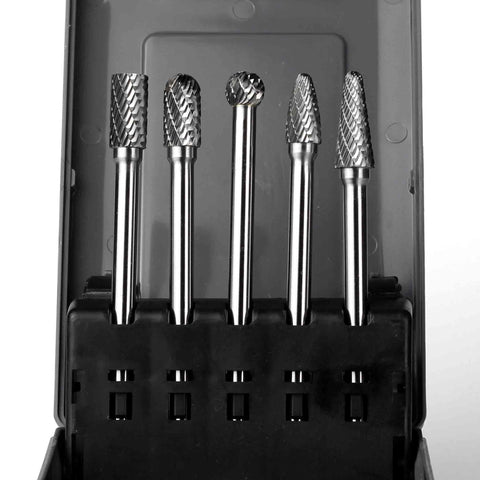Carbide rotary burrs, often referred to as carbide burrs or rotary files, are indispensable tools in various industries, ranging from metalworking and woodworking to sculpting and jewelry making. These small, yet powerful, cutting tools are designed to shape, remove material, and create intricate details with exceptional precision. In this article, we will explore the features and applications of carbide rotary burrs, uncovering the secrets behind their versatility and popularity.
Carbide rotary burrs consist of a steel shank and a cutting head made of tungsten carbide, a compound renowned for its hardness and durability. The tungsten carbide particles are bonded together by a binder, typically cobalt, which adds strength and resistance to heat. This combination of materials makes carbide rotary burrs capable of withstanding the demanding tasks encountered in metalworking, woodworking, and other creative disciplines.
One of the key advantages of carbide rotary burrs is their versatility in shaping and removing material. The cutting head of the burr features sharp, fluted edges that effectively cut through various materials, including metals, woods, plastics, and composites. With different shapes and tooth configurations available, carbide burrs can remove material quickly, shape surfaces precisely, and create intricate details effortlessly.
Carbide rotary burrs come in a wide range of shapes, each designed for specific applications. Some common shapes include cylindrical, ball, flame, tree, and cone. Cylindrical burrs are versatile and ideal for general material removal and shaping. Ball-shaped burrs are excellent for concave surfaces and blending edges. Flame-shaped burrs excel at creating channels, contours, and intricate designs. Tree-shaped burrs are perfect for reaching tight spaces and shaping curved surfaces. Cone-shaped burrs are effective for deburring, chamfering, and creating tapered holes. The availability of various shapes allows craftsmen to select the most suitable burr for their specific projects, unleashing their creativity and achieving remarkable results.
The tooth configuration or cut type of a carbide rotary burr is another important consideration. There are generally three types: single cut, double cut, and diamond cut. Single cut burrs have a single set of teeth arranged in a diagonal pattern, providing a smooth finish and light material removal. Double cut burrs feature two sets of teeth in a crossed pattern, offering faster material removal and a slightly rougher finish. Diamond cut burrs have a unique pattern of multiple small cuts, providing aggressive material removal and a coarse finish. The choice of tooth configuration depends on the desired material removal rate and finish quality for a specific project.
Carbide rotary burrs find applications in a wide range of industries. In metalworking, they are used for deburring, shaping, grinding, and porting tasks. Metalworkers rely on carbide burrs for precision work, such as creating grooves, chamfers, and intricate patterns. Woodworkers utilize carbide burrs to shape and sculpt wood, carve intricate designs, and create decorative accents. Sculptors and artists employ carbide burrs for shaping and detailing various materials, including stone, plaster, and resin. Jewelers and craftsmen use carbide burrs to engrave designs, refine settings, and create stunning jewelry pieces. The versatility of carbide rotary burrs extends to automotive, aerospace, and DIY applications, where they excel at tasks such as weld preparation, removing rust, and shaping fiberglass.
It is important to note that safety precautions should always be taken when using carbide rotary burrs. Eye protection, gloves, and proper ventilation are essential, as the burrs generate fine debris and can cause sparks. Using the burrs at the appropriate speed and applying gentle, controlled pressure ensures optimal performance and reduces the risk of accidents or damage to the workpiece.
In conclusion, carbide rotary burrs are versatile and powerful cutting tools that unlock a world of possibilities in metalworking, woodworking, sculpting, jewelry making, and various other creative fields. With their exceptional precision, durability, and variety of shapes and tooth configurations, carbide burrs empower craftsmen to shape, remove material, and create intricate details with ease. By incorporating carbide rotary burrs into their toolkits, artisans can unleash their creativity and achieve outstanding results in their projects.
If you want to know more details about carbide rotary burrs, you can visit to FindBuyTool to take a look, where there includes kinds of bits and sizes you need.
